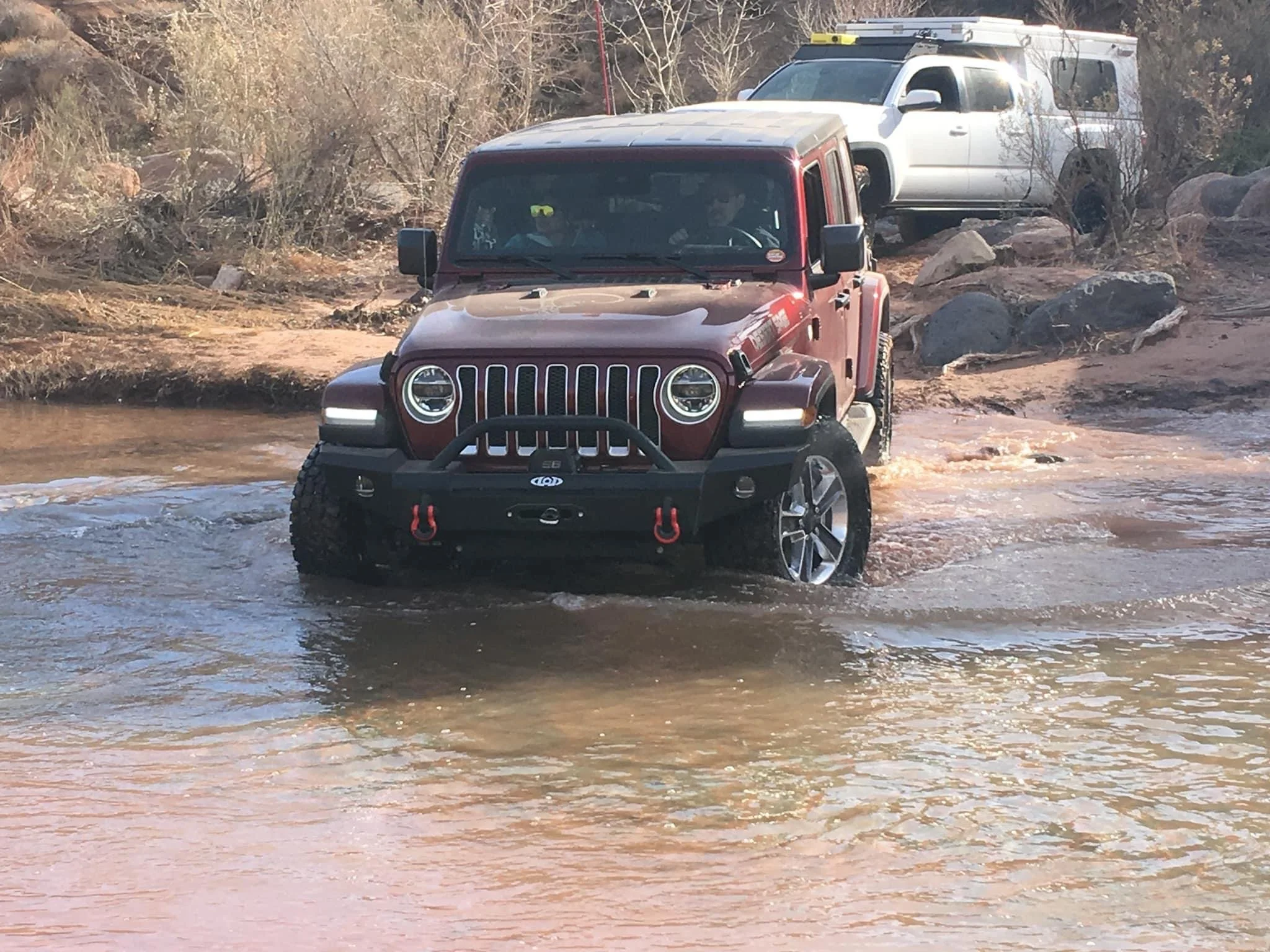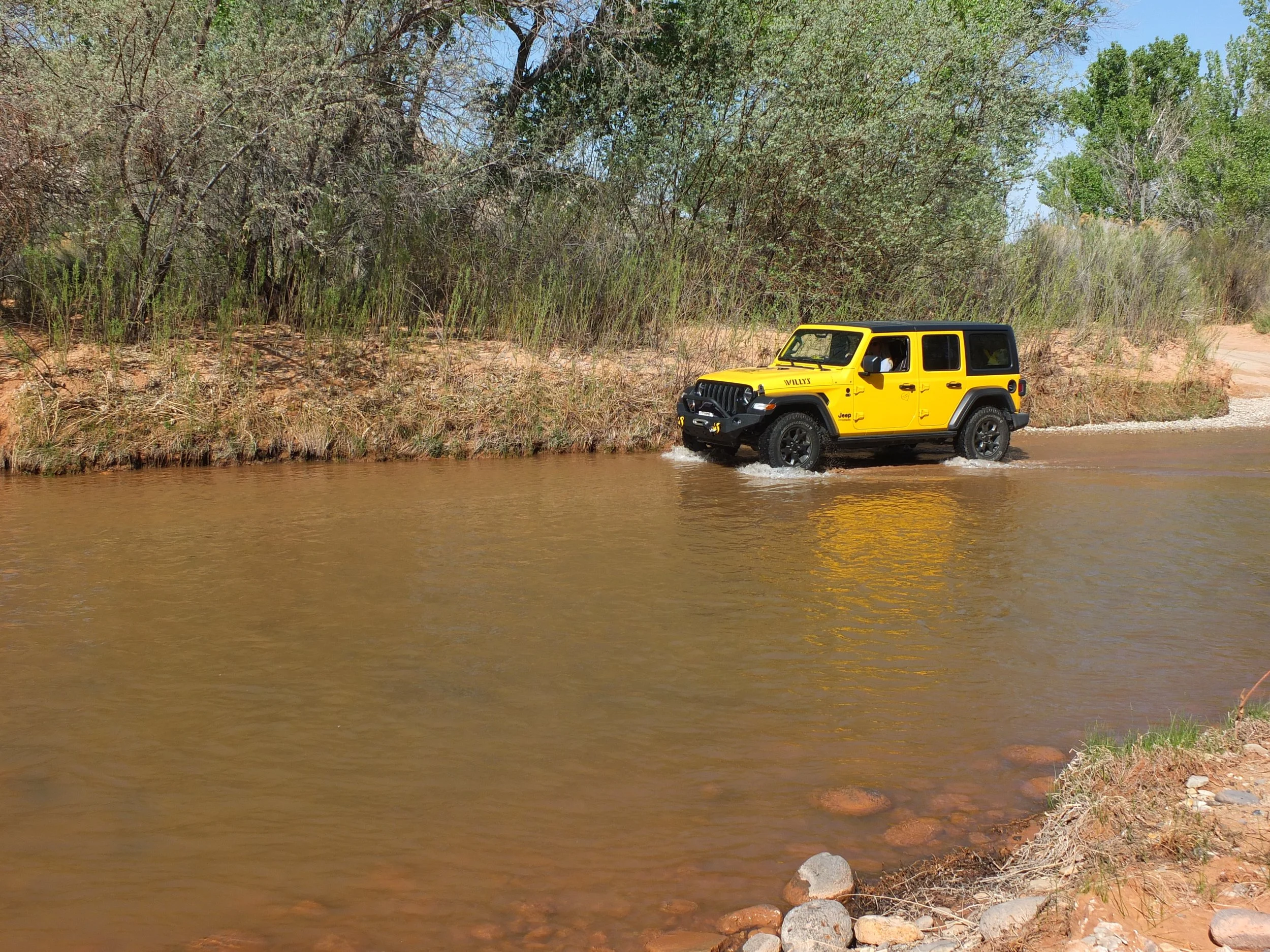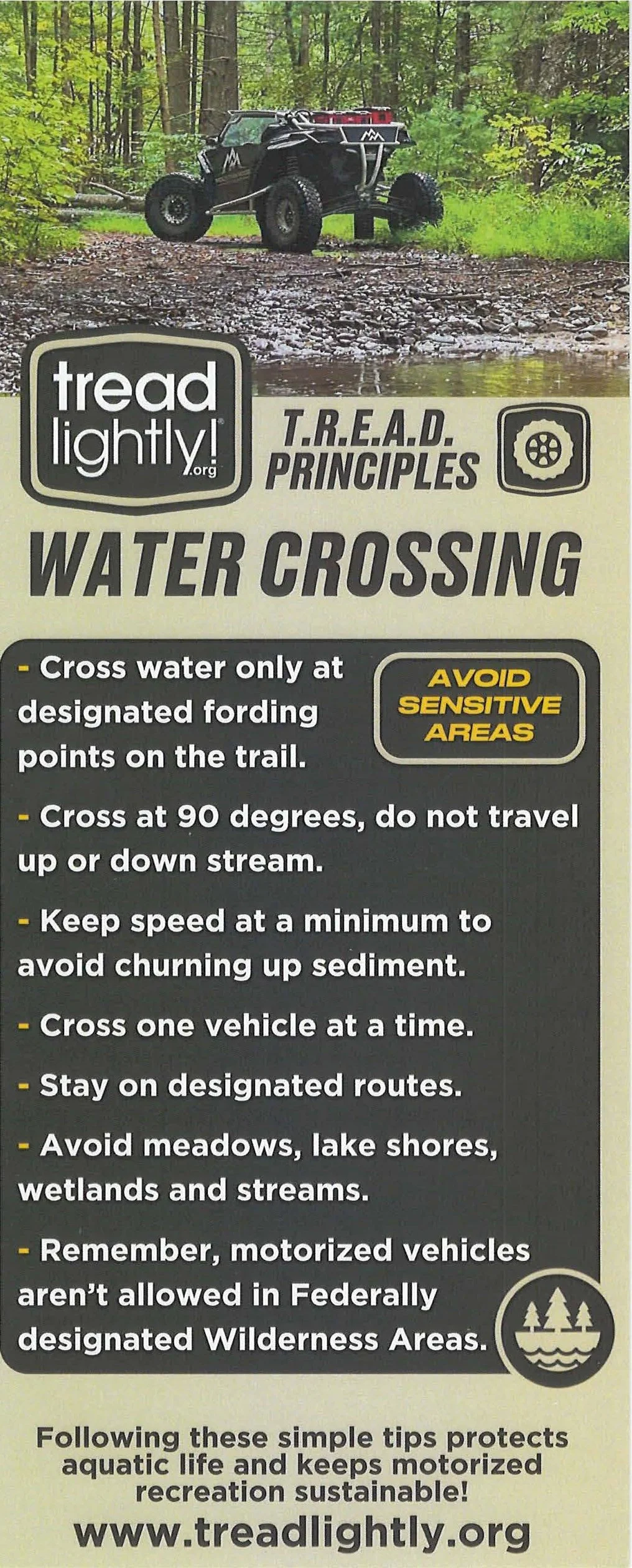Water Crossings
Jeep entering the water crossing at Toquerville Falls, Utah.
written by Fred Ginsburg
Here are a few things that beginners should know about water fording in a Jeep.
Jeeps are not boats. Offroad does not mean offshore. One of the great marketing myths is that Jeeps are impervious to water, and that it is okay to ford rivers or streams in your path.
Let me preface this article by emphasizing that my wife and I thoroughly enjoy water crossings and are not trying to dissuade you from attempting them. However, as in all things offroading, we all need to be cautious and cognizant of the risks.
First, let’s discuss the inherent risks of the obstacle itself – in this case, the actual water. Then, we will examine the vulnerabilities of our Jeep when partially submerged.
Let’s start with the river or creek itself.
Is the water static or flowing? Any body of moving water has the potential to sweep even heavy vehicles downstream. If the river flow is brisk, and the depth is more than 10 inches or so – use extreme caution. Do not underestimate the force of that current. Think about attaching recovery lines BEFORE attempting to cross. Better yet, just don’t take the risk. YouTube is filled with videos of cars being swept downstream.
The next danger of the obstacle is the riverbed itself.
Is it flat and even, or peppered with unseen ditches, gullies, and deep pits?
What kind of surface will we be driving over? Firmly packed or soft silty sand? Suction-cup mud, or something less entrapping? Sliprock, small stones/gravel?
Are there any big things looming under the water surface? Larger rocks, tree limbs, steps/ledges?
If we are playing in a dedicated OHV area or crossing a popular trail -- especially one that has been reviewed numerous times online – we can probably assume that there is nothing nasty.
Jeep crossing the river at Cathedral Loop near Capitol Reef National Park.
For example, outside Capitol Reef National Park is the Cathedral Loop. The trail begins with a shallow (several inches) river crossing, which is even marked in the park brochures. The rangers have checked it, so we knew that it posed no danger to high clearance 4x4’s.
But if our water crossing is not well documented, then someone must roll up their pants and get wet. Grab a long stick and probe along the intended path as if you are in a minefield. The stick will alert you to underwater hazards before you trip over something or plunge into a deep hole.
Inspect the entry and exit banks. Are they gradual inclines, or steep nose-dives? Is the ground firm enough for our tires to get some traction, especially when exiting the water?
The first vehicle to cross should have a working winch. If they cannot climb the bank, at least they can pull themselves up. Sometimes, the first few Jeeps will be okay, but each successive vehicle erodes and loosens the bank – requiring later vehicles to be assisted.
How water resistant is your Jeep?
Jeep recommends maximum water fording depth of 30 inches.
Jeeps include a plaque on the inside of the tailgate claiming that Wranglers can safely ford up to a depth of 30 inches, traveling at a steady 5mph in slow flowing or static water.
MOPAR doesn’t promise that your feet will remain dry! There are drain plugs under your floor mats that need to remain sealed. Those openings in the floorboard allow you to rid the cabin of water from driving topless in the rain, or hosing out dirt. There is also a plug in the hidden storage compartment under the trunk liner. As you can guess, if these plugs are not tightly seated – water can seep into the footwells.
The axles and differentials are filled with fluids which can build up excess pressure during use. There are small openings at the top of both axles, and the transfer case, to vent excess build-up. Small hoses, known as breather tubes, connect to these vents to snorkel these openings higher up the car body. The tubes are also fitted with directional valve caps that are water resistant (but not fulltime waterproof).
The tops of these breather tubes should be kept above the water line. The rear tubes are located in the back of the wheel wells, slightly above the top of the tire. The front tubes can be seen near the coil springs. They can handle being submerged for short periods, but don’t park in the water for prolonged times while partying at a cove. The longer that these tubes remain underwater, the greater likelihood of water seeping in and mixing with your diff fluids. If you excessively expose your tubes to water -- you will probably be okay getting home, but need to drain & replace those fluids asap.
Your other area of concern is getting water too high up in the engine compartment. Just under the hood is the air intake, where your engine air filter resides. You do not want any water getting into that opening. If water gets sucked into your engine, it can destroy it! Jeeps do have a water sensor on the other side of the air filter, which will shut down the engine if it detects too much moisture.
We have seen Jeeps stall out completely on account of just a wee bit of water tripping that sensor. If it is only minor moisture, you might be able to remove the air filter and air dry the channel out. More serious leakage into the engine block could involve removal of the spark plugs and other therapeutic mechanical remedies to vent water pressure and dry things out – too complicated to discuss in this beginner’s article. But if your engine does stall on account of water intake – DO NOT try to force start it. That could draw water into the cylinders, create pressure, and seriously wreck things.
Besides the air intake, you have a lot of electrical connections at the top of your engine. Water conducts electricity, which means it will short circuit your system. Battery terminals are exposed. Power strips, fuse banks, after-market wiring for accessories. And don’t forget your alternator.
Jeeps are better than most vehicles because these electrical connections are kept in the upper reaches of the engine compartment. But if the water should breech too high, it will cause a heap of hurt!
Then there is the radiator fan. Better known to sailors as a big propeller.
So how can Jeeps be improved to minimize water risk?
Breather tubes can be extended with longer hoses to raise them higher.
Snorkels can be fitted to raise the level of your air intake. Most of the time, the primary benefit of a snorkel is to reduce the dust & dirt on a trail by getting above the worst of the dust clouds. However, some snorkels can create a watertight seal at the hood level. Make sure that your new snorkel is not just for cosmetic looks but really does afford protection.
That still leaves the exposed electrical connections. Lots of meticulous refitting of all the connecting points along with application of chemical sealants.
Just like hardcore rock crawlers have morphed their machines into mountain goats, serious water forders have also devoted a lot of effort into optimizing their rigs.
Having discussed the risks of water fording, let’s examine techniques for our mostly non-waterproofed Jeeps.
Tread Lightly guide to water crossing
Water fording depth: Jeep says up to 30 inches. That is under the height of a fully inflated stock tire (29-31 inches), or several inches under a 35 inch. Don’t forget, you have already aired down, so the top of your 35’s are no longer 35 inches!
30 inches deep is MAXIMUM water depth in nearly static water. If there is a current, limit yourself to shallower depth.
Many drivers only want the water level either to be a little above the center hub of their tires, or not exceeding the rock rail level of their doors. Maybe just 18 inches or so.
18 inches may not seem very deep, but moving water can lift a Jeep and carry it downstream. Best to play it conservatively.
Obviously, Jeeps with extra tall tires (37+) and lifts can handle deeper crossings, but on our trail runs we need to factor for minimally equipped vehicles.
Be very careful about descending the bank as you enter the water. A steep angle will nose dive you and risk submerging your engine hood until your Jeep levels out!
During the crossing, maintain a steady speed and do not lose momentum. If you stop in soft sand, you might dig your tires in and become stuck.
Target around 5 mph. Hopefully, your front bumper will generate a small wake in front of you and push the water away.
If you have to travel up or downstream to the exit bank, hug close to the bank rather than the center of the stream. Traverse across the stream on an angle, to compensate for the current.
“Crossing small streams and creeks is a lot of fun. But do be careful. And travel with a group. ”





